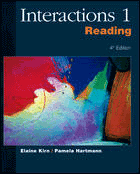 |  Interactions 1 Reading, 4e Elaine Kirn,
West Los Angeles College
Pamela Hartmann,
Los Angeles Unified School District
TestingA. Types of Tests
The Interactions Mosaic series includes a placement test for dividing students into the appropriate levels at the beginning of a course and a quiz for each chapter in the Instructor's Manual. Diagnostic testing, finding problem areas for individuals and classes, should be an ongoing process.
B. Timed Readings
It is essential that students understand that reading rates will vary according to the type and purpose of the reading. Inform your students that the average native speaker reads relatively easy material at about 250 words per minute with 70% comprehension. The average reading rate for college students is about 300 words per minute with 70% comprehension.
If your students are particularly interested in improving their reading speed, you can occasionally conduct informal timed tests.
- Choose a relatively short passage or part of a passage—one that most students can finish in less than five minutes.
- If possible, the passage should be on a topic that they know something about.
- Count the words in the passage.
- Prepare a few general comprehension questions about the passage.
- Take a clock to class if there isn't one in the room.
- Distribute the passage to students face down on their desks.
- Tell them to read the passage as quickly as possible and to raise their hands when they are finished.
- Tell them to begin reading and note the time.
- Note the time as each student finishes and give each one a copy of the comprehension questions. Tell them not to look back at the passage. When everyone is finished, go over the answers to the questions.
- Have students figure out their reading speed by dividing the number of words in the passage by their time. Tell students that they should be able to answer with at least 70% accuracy. If they did not, they were reading too fast.
|
|



 2002 McGraw-Hill Higher Education
2002 McGraw-Hill Higher Education

 2002 McGraw-Hill Higher Education
2002 McGraw-Hill Higher Education